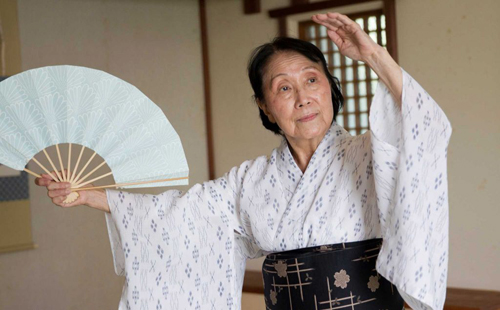By Steven Mark

Gertrude Yukie Tsutsumi
HONOLULU (AP) — Watching a fan in the hands of Gertrude Yukie Tsutsumi is like watching a feather dance in the breeze. She holds it out like a mirror and lets it fall toward her forearm, catching it with a well-timed but casually graceful sweep of her wrist.
“Let gravity take care of it and the movement comes naturally,” she says. “You don’t let the fan manipulate you — you manipulate the fan.”

Gertrude Yukie Tsutsumi
For Tsutsumi, 85, a retired public school teacher, Japanese classical dancing has been a way of life. She grew up watching her family members dance and began formal training as a child. Through the years, her passion for dancing has taken her to the Far East to train with Japanese masters.
Recently, however, her dancing and teaching sent her in the opposite direction, to the East Coast. In a ceremony in Washington D.C., she was recognized as a 2015 National Heritage Fellow. The fellowship, awarded by the National Endowment of the Arts, is the nation’s highest honor for folk and traditional artists.
The recognition, she says, is “too big.”
Her style of dancing, “nihon buyo,” dates back to 17th-century Japan and is known for its elaborate makeup and costuming. The dances, performed to music from traditional Japanese instruments, range from historical narratives to descriptive portrayals of nature.
“If you’ve got a big umbrella, nihon buyo is in the center like the stem, because we borrow a lot from the noh theater and kabuki but we also take from folk dances,” she explains. “So it’s a dance that stems from many other dances, but mainly noh and kabuki.”
Tsutsumi grew up in Honolulu, the daughter of a Japanese-born hospital worker and his nisei wife.
She began her formal training at age 8 with Bando Mikayoshi, one of the early teachers of nihon buyo in Hawaii. She also studied with Japanese dancers who visited Honolulu, a fairly common practice in the prewar era.
“I loved music and dancing. I loved watching all kinds of dancing, and this was mostly what I was exposed to,” she said.
In 1956, after finishing university and starting her teaching career, she traveled to Tokyo “to at least see Japan.” Through a family acquaintance, she met the master of a major nihon buyo school in Tokyo, the Onoe Kikunojo School, and wound up studying there for a year. She has now studied with three generations of masters from that school, which is noted for its technique with fans.
“Many other schools in Japan, they came to my teacher, and they learn a lot about how to manipulate the fan,” she said.
The Onoe Kikonojo School would eventually bestow upon her a professional name, Onoe Kikunobu, an honor that allowed her to open her own school, Kikunobu Dance Company. Founded in 1964, the school has seen 13 of its students earn the designation of master dancer.
Her students are steeped in the tradition of the dance, even learning how to notate dances with stick figures to depict the footwork and filing the information away in small notebooks.
“I have tons of them,” she said of the notebooks, adding with a laugh, “Now we have DVD.”
Tsutsumi also taught at many other local theater groups, such as the Honolulu Theatre for Youth and Kumu Kahua Theatre. For more than 20 years, she helped the University of Hawaii at Manoa’s Department of Theatre and Dance with its kabuki productions, passing on that responsibility to one of her students, Howard Asao, a few years ago.
Asao, 71, was one of Tsutsumi’s first students. He said a performance by Japan’s Grand Kabuki Theatre in 1964 at the then-new Blaisdell Center (formerly known as the Honolulu International Center) inspired him to take up the art form.
“Learning Japanese dance, you not only learn the dance, but you learn the language and the history and the culture, not just of the present, but the past,” said Asao, who still meets regularly with Tsutsumi to practice.
Another student, Linda Tatsuno, has been studying with Tsutsumi for only a year. As a youngster she was forced by her parents to go to weekend dance school. Now, after a “45-year break,” she’s rediscovering her roots through dance.
“My focus is different now,” said Tatsuno, 67, who is trying to learn a traditional dance about a wounded heron. “Back then I could do the mechanics of it. Now, in my twilight years, I want to learn the spirit of it. Sensei is so good at the spirits and the mechanics, and she has immense patience.”
Tsutsumi’s school attracts people from all walks of life. She’s taught ballet dancers, children and non-Japanese students. One of her students is Jordan Ragasa, 24, who is of Filipino descent. He grew interested in nihon buyo through bon dancing.
“It was challenging at first because there’s lots of form and rigor to it, but after a while I grew to like that,” he said. “It’s very simple but it’s very elegant. There’s elegance in that simplicity.”
Tsutsumi has performed in major theaters in Japan, including the National Theater of Japan and the Kabuki-za, the principal kabuki theater in Tokyo. She’s received many honors and awards, including recognition from the Hawaii State Foundation on Culture and the Arts and the Pan-Pacific Festival.
Her approach to dance reflects the ascetic qualities of Japanese art.
“Some people do frivolous things with their dance,” Tsutsumi said. “The philosophy for my school is the most beautiful movement without waste and the connection between the movements. You have to have meaning and use the most beautiful way you can do it without being wasteful.” (end)



